The Love Triangle Spread
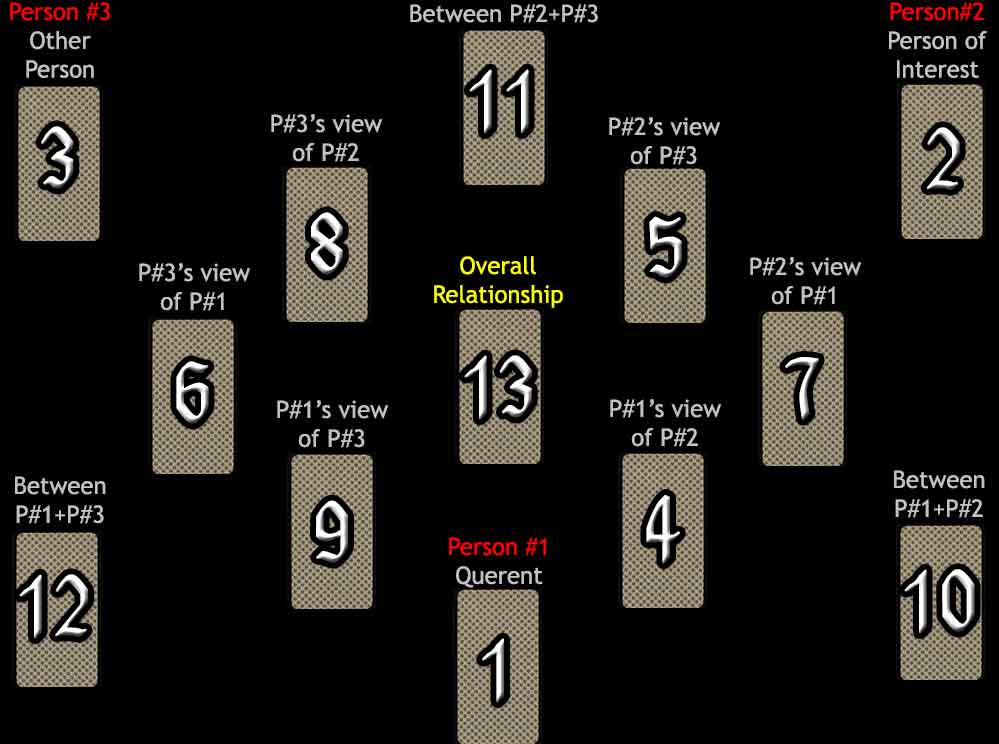
Difficulty: Complicated
Casually referred to as the Love Triangle, this spread can be used to determine the dynamics of the relationship between three people, regardless of whether romance is involved. This spread is arranged in the form of a hexagram, consisting of several large and small triangles. This tarot spread may seem somewhat complicated, but it is not entirely that difficult.
The first step is to interpret the card for each individual position in the spread. Generally, one might ask about a relationship they are involved in, but this does not have to be the case. Ordinarily, the reader's representative card is #1, their main person of interest is #2, and the other person would be #3.
The second step fills in the downward triangle and involves further examination of the individuals through their views of the other people. Each person has two more cards showing the way they see and relate to the other members of the triangle. For example, Card #6 indicates how Person #3 relates to Person #1, while Card #9 stands for Person #1's attitude toward Person #3.
The next step completes the upward triangle and the hexagram, focusing on cards #10–13. It also completes the many smaller triangles and hints at the potential for each relationship. The final card, #13 can be considered the significator of the reading, which suggests the overall potential for this three-way relationship.
Your Love Triangle Reading
| P#3 | 3to2 | 2+3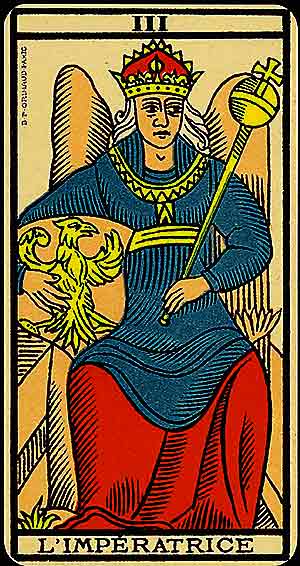 |
2to3 | P#2 | ||
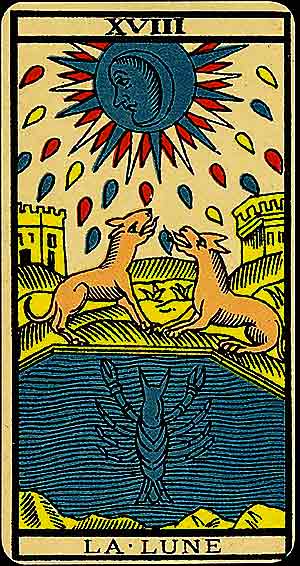 |
3to1 | 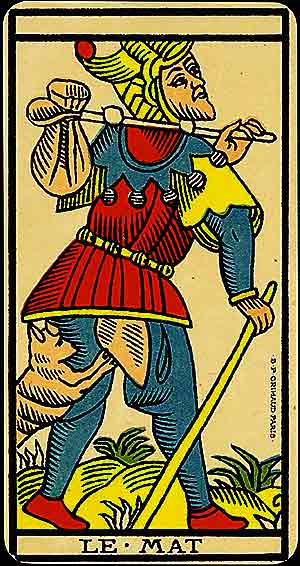 |
Overall | 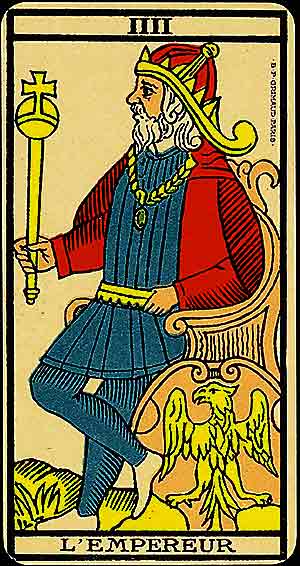 |
2to1 | 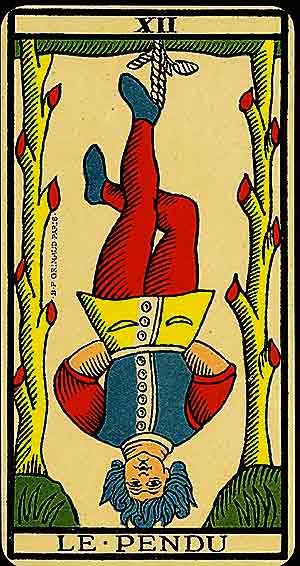 |
| 1+3 |  |
1to3 | 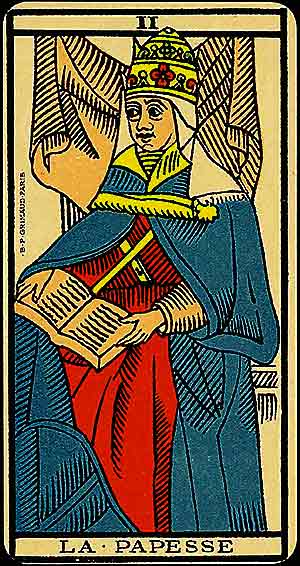 |
1to2 | 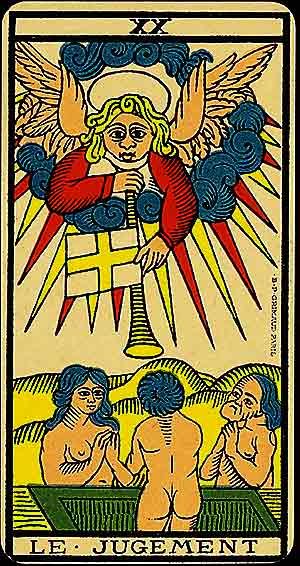 |
1+2 |
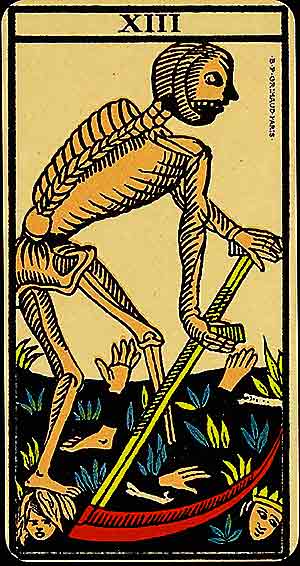 |
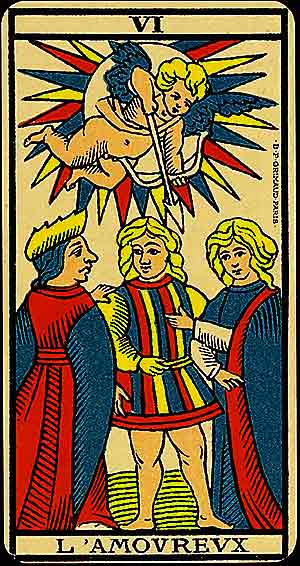 |
P#1 | 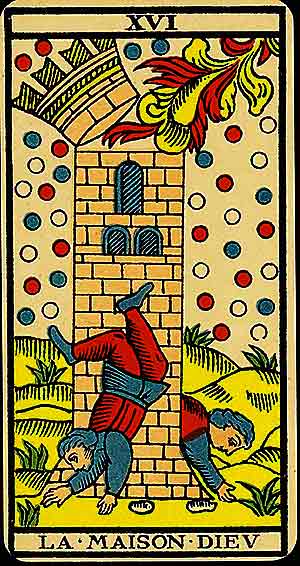 |
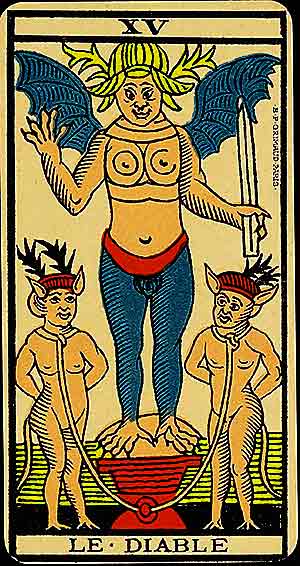 |
||
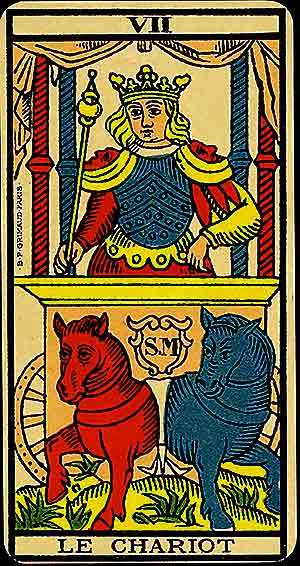 |
1: Person #1

(Le Chariot)
Symbolism:
The Chariot shows a warrior standing in a chariot pulled by two horses of contrasting colors, symbolising opposing forces. The warrior wears a crown and holds a wand or reins, signifying control and determination. The canopy above him suggests moving forward from a place of stability into the unknown.
Meaning:
The Chariot signifies triumph through determination, discipline, and focus. It speaks to mastering conflicting forces and steering your life toward success. This card often appears when you are on the brink of achieving a goal, but it reminds you that persistence and self-control are essential.
In relationships, the Chariot suggests navigating challenges together. Spiritually, it emphasises aligning your willpower with your higher purpose.
Keywords:
Triumph, determination, focus, control, discipline, victory, mastery, momentum, perseverance, alignment.
2: Person #2

(Le Pendu)
Symbolism:
The Hanged Man is shown suspended upside-down by one foot from a live tree, with his free leg bent to form a cross-like shape. His serene expression suggests surrender rather than distress. This represents enlightenment gained through sacrifice or altered perspective. The tree may symbolise the axis mundi, a bridge between worlds.
Meaning:
The Hanged Man symbolises surrender, letting go, and viewing situations from a different perspective. It suggests a pause or suspension of action, encouraging reflection and patience. This card often appears when you need to relinquish control or embrace sacrifice to gain deeper understanding.
In relationships, it can signal a need for a fresh outlook or willingness to adapt. Spiritually, it points to awakening through non-resistance and the acceptance of higher truths.
Keywords:
Surrender, perspective, patience, sacrifice, reflection, letting go, enlightenment, suspension, adaptation, non-resistance.
3: Person #3

(La Lune)
Symbolism:
The Moon hangs high in the sky, casting a dim, mysterious light over a landscape. A dog and a wolf howl at the moon, representing instincts and the untamed subconscious. A pool sits between two towers, suggesting the unknown. A crayfish crawls out of it, symbolising hidden emotions emerging.
Meaning:
The Moon represents intuition, mystery, and the subconscious. It suggests a time of uncertainty where not everything is as it seems. This card invites you to trust your instincts and explore hidden depths. It also warns against illusion or confusion, urging clarity.
In relationships, it can indicate emotional complexity or hidden dynamics. Spiritually, it calls for embracing intuition and the mysteries of the psyche.
Keywords:
Intuition, mystery, subconscious, illusion, uncertainty, emotions, dreams, instincts, exploration, hidden truths.
4: Person #1's view of #2

(La Maison Dieu)
Symbolism:
A tall tower struck by lightning collapses as figures fall from its heights, symbolising sudden upheaval. Balls and debris erupt from the structure, representing destruction and chaos. However, the lightning bolt signifies divine intervention, clearing away illusions and false foundations to reveal the truth.
Meaning:
The Tower represents sudden change, upheaval, and the collapse of false structures. While the experience may be shocking or painful, it paves the way for transformation and rebuilding. This card calls for resilience and the ability to embrace new beginnings born from chaos.
In relationships, it may signal a dramatic shift or revelation. Spiritually, it urges you to let go of false beliefs and align with authenticity.
Keywords:
Upheaval, change, chaos, destruction, revelation, transformation, truth, divine intervention, awakening, rebuilding.
5: Person #2's view of #3

(L'Empereur)
Symbolism:
The Emperor sits firmly on a throne adorned with symbols of strength and authority. His scepter and orb signify dominion over the material world, while his armour beneath the robes suggests readiness to defend his position. The rocky landscape at his feet symbolises stability and enduring power.
Meaning:
The Emperor represents structure, discipline, and the establishment of order. He embodies the qualities of leadership and protection, encouraging you to take charge of your circumstances with clarity and determination. This card often points to the need for planning, responsibility, and stability.
In relationships, the Emperor stresses respect, loyalty, and shared goals. Spiritually, he reminds you that boundaries and structure are essential for growth.
Keywords:
Authority, structure, discipline, stability, leadership, protection, responsibility, planning, boundaries, foundation.
6: Person #3's view of #1

(L'Hermite)
Symbolism:
The Hermit is an elderly figure carrying a lantern and a staff. The lantern symbolises inner wisdom and guidance, while the staff represents support and stability. His cloak signifies introspection, reflecting the solitude of his journey.
Meaning:
The Hermit represents introspection, wisdom, and solitude. He invites you to step back from external distractions and seek answers within. This card often appears during periods of self-discovery, encouraging you to listen to your inner voice.
In relationships, the Hermit may indicate a need for personal space or reflection. Spiritually, it highlights the quest for enlightenment and the value of solitary contemplation.
Keywords:
Wisdom, introspection, solitude, guidance, reflection, self-discovery, enlightenment, patience, inner truth, retreat.
7: Person #2's view of #1

(Le Jugement)
Symbolism:
An angel blows a trumpet as figures rise from coffins below, symbolising resurrection and awakening. The praying hands of the figures reflect surrender and acceptance. The bright light of the angel signifies divine calling and revelation, while the mountains in the background represent challenges overcome.
Meaning:
Judgement represents awakening, self-assessment, and rebirth. It signals a time to evaluate your past and make amends, preparing for a new chapter. This card often appears when you are called to align with your higher purpose and embrace transformation.
In relationships, it suggests healing, forgiveness, or a new beginning. Spiritually, it encourages connection with your true calling.
Keywords:
Awakening, transformation, rebirth, judgement, self-assessment, forgiveness, redemption, clarity, divine calling, renewal.
8: Person #3's view of #2

(Le Mat)
Symbolism:
A carefree figure, often carrying a small bag or bundle, walks toward the unknown with a dog nipping at their heels, symbolising the risks of new beginnings. Their gaze is upward, indicating innocence and trust, while their attire features bright, mismatched colours, emphasising their unconventional nature.
Meaning:
The Fool represents new beginnings, spontaneity, and the embrace of life's uncertainties. This card encourages stepping into the unknown with optimism and trust, even if the path ahead seems uncertain or risky. It speaks to freedom, potential, and the ability to approach life with a beginner's mind.
In relationships, the Fool may suggest a fresh start or a need for openness and vulnerability. Spiritually, it represents a journey of self-discovery and the willingness to trust the universe.
Keywords:
New beginnings, spontaneity, innocence, freedom, potential, adventure, risk, trust, exploration, unconventionality.
9: Person #1's view of #3

(L'Amoureux)
Symbolism:
The Lovers card depicts a man standing between two women, with Cupid above aiming an arrow. The scene suggests a choice or a union, with the women often representing opposing influences. In some interpretations, the figures are Adam and Eve, symbolising the duality of earthly and spiritual love.
Meaning:
The Lovers represent connection, harmony, and the power of choice. This card speaks to deep relationships, whether romantic or platonic, and the alignment of values and goals. However, it also highlights the necessity of making meaningful decisions, often at a crossroads where the heart and mind must collaborate.
In relationships, the Lovers symbolise love, commitment, and mutual respect. Spiritually, they encourage balancing the dualities within yourself and finding unity in diversity.
Keywords:
Love, harmony, connection, choice, duality, relationships, unity, attraction, alignment, crossroads.
10: Overall relationship between persons #1 and #2

(Le Diable)
Symbolism:
The Devil is portrayed as a horned figure with two chained human figures below, representing bondage to materialism or desires. The chains are loose, suggesting self-imposed limitations. Their animalistic features symbolise the materialism and polarity of nature.
Meaning:
The Devil represents temptation, materialism, and the shadow side of human nature. It highlights unhealthy attachments, addictions, or fears that may be holding you back. This card calls for awareness and the courage to break free from self-imposed limitations.
In relationships, it warns of codependency or power imbalances. Spiritually, the Devil challenges you to confront and integrate your shadow self.
Keywords:
Temptation, bondage, materialism, addiction, fear, control, power, shadow self, self-awareness, liberation.
11: Overall relationship between persons #2 and #3

(L'Impératri
Symbolism:
The Empress sits on her throne, holding a scepter that signifies authority. A shield bearing the symbol of Venus is nearby, emphasising love, fertility, and creation. She is adorned in flowing robes, indicating abundance.
Meaning:
The Empress is the archetype of creation and abundance, representing fertility, nurturing, and growth in all aspects of life. She is a motherly figure who provides support and encouragement, guiding you to cultivate your ideas or relationships into something beautiful. Her presence suggests a time of prosperity and fulfilment.
In relationships, she signifies a loving, nurturing connection. Spiritually, she urges you to embrace the rhythms of nature and the divine feminine within you, celebrating life's creative energy.
Keywords:
Creation, abundance, fertility, nurturing, growth, love, prosperity, nature, creativity, fulfilment.
12: Overall relationship between persons #1 and #3

(La Mort)
Symbolism:
A skeletal figure wielding a scythe moves through a barren landscape. Heads, hands, and flowers lie beneath the scythe, symbolising the inevitable end of all things. Despite its grim imagery, the card signifies renewal and the promise of rebirth.
Meaning:
Death represents transformation, endings, and the clearing away of the old to make space for the new. This card doesn't predict physical death but rather signifies a profound shift or transition. It invites you to release attachments and embrace the inevitability of change.
In relationships, Death can mark the end of a phase, whether through growth or closure. Spiritually, it emphasises rebirth, renewal, and the cycles of life.
Keywords:
Transformation, endings, rebirth, change, renewal, transition, letting go, closure, release, metamorphosis.
13: Overall 3-way Relationship

(La Papesse)
Symbolism:
The High Priestess is shown seated, holding an open book, signifying hidden knowledge and mysteries. She is flanked by two pillars (sometimes black and white), representing duality and balance. Her veil hints at the separation between the conscious and subconscious. Her serene expression reflects her mastery of the inner world and her connection to divine intuition.
Meaning:
The High Priestess embodies mystery, wisdom, and the power of intuition. She encourages stillness and reflection, guiding you to trust your inner voice over external noise. This card often appears when something hidden needs to be uncovered, whether it's a secret, a truth, or a deeper understanding of oneself.
In relationships, the High Priestess may suggest emotional depth or hidden dynamics. Spiritually, she symbolises the gateway to higher knowledge, urging you to explore the realms of dreams and symbols to uncover your truth.
Keywords:
Intuition, mystery, inner wisdom, reflection, subconscious, hidden knowledge, spirituality, patience, introspection, stillness.
